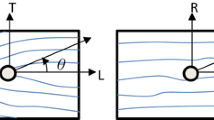Summary
Applying modern methods of analyzing floor, wall, and connection subsystems in light-frame wood buildings requires information on the stiffness of nailed joints under long-term loads. Because this information can best be derived by testing nail-joint specimens under constant loads, theoretical procedures were developed that use test data for constant loads to predict stiffness under variable in-service loads; five nonlinear, viscous-viscoelastic models were develpoed on the basis of existing formulations of creep and mechanisms of load transfer between nails and wood. The models incorporated the modified superposition and strain-hardening principles in describing responses to discrete or continuous loading functions. Tests have shown that the models closely predict creep slip of typical nailed joints.
Similar content being viewed by others
References
Cho, U. W.; Findley, W. N. 1980: Creep and creep recovery of 304 stainless steel under combined stress with a representation by a viscous-viscoelastic model. J. Appl. Mech. 47: 755–761
Findley, W. N.; Lai, J. S. 1967: A modified superposition principle applied to creep of nonlinear viscoelastic material under abrupt changes in state of combined stress. Trans. Soc. Rheol. 11 (3): 361–380
Findley, W. N.; Lai, J. S. 1978: Creep and recovery of 2618 aluminum alloy under combined stress with a representation by a viscous-viscoelastic model. J. Appl. Mech. 45: 507–514
Jang, S. 1987: Prediction models for creep behavior of nailed joints between Douglas-fir lumber and plywood. Ph.D. Dissertation, Department of Forest Products, Oregon State Univ., Corvallis, OR
Nolte, K. G.; Findley, W. N. 1971: Multiple step, nonlinear creep of polyurethane predicted from constant stress creep by three-integral representation. Trans. Soc. Rheol. 15 (1): 111–133
Onaran, K.; Findley, W. N. 1965: Combined stress-creep experiments on a nonlinear viscoelastic material to determine the kernel functions for a multiple integral representation of creep. Trans. Soc. Rheol. 9 (2): 299–327
Pierce, C. B.; Dinwoodie, J. M. 1977: Creep in chipboard. Part 1: Fitting 3- and 4-element response curves to creep data. J. Mater. Sci. 12: 1955–1960
Pierce, C. B.; Dinwoodie, J. M.; Paxton, B. H. 1985: Creep in chipboard. Part 5: An improved model for prediction of creep deflection. Wood Sci. Technol. 19: 83–91
Polensek, A. 1982: Creep prediction for nailed joints under constant and increasing loading. Wood Sci. 15 (2): 183–192
Author information
Authors and Affiliations
Additional information
This research was jointly supported by the Forest Research Laboratory, Oregon State University, and the Cooperative State Research Service, U.S. Department of Agriculture, Special Grant 85-CRSR-2-2553. This is Paper 2288 of the Forest Research Laboratory
Formerly Graduate Research Assistant Forest Research Laboratory
Rights and permissions
About this article
Cite this article
Jang, S., Polensek, A. Theoretical models for creep slip of nailed joints between wood and wood-based materials. Wood Sci. Technol. 23, 237–249 (1989). https://doi.org/10.1007/BF00367737
Received:
Issue Date:
DOI: https://doi.org/10.1007/BF00367737




